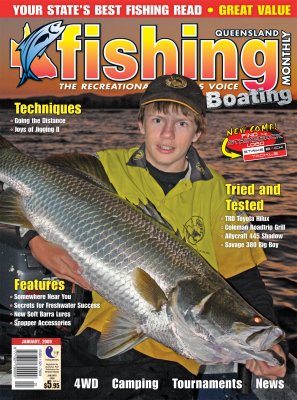Going the Distance: A Topographical Guide to Fishing in Northern Queensland by Lee Brake
 Most of us realise that the species, environment and behaviour of recreational fish change as you travel further offshore and to truly make the most of these 'species bands', it becomes necessary to change techniques to suit your location.
Most of us realise that the species, environment and behaviour of recreational fish change as you travel further offshore and to truly make the most of these 'species bands', it becomes necessary to change techniques to suit your location.
Obviously, a complete analysis could fill a book, so for the moment let's concentrate on a basic overview of the inshore islands and headlands, the shoals and outer islands, the deepwater shoals and structure and the barrier reef. Each has its own set of trials and tribulations, so by attacking each one differently, you'll be maximizing your results.
BAND 1: THE INSHORE ISLANDS AND SHOALS
The name of the game here is to fish light! These areas are perfect habitats for a whole range of species and they are in easy reach of even the smallest tinny. Your best option is to targeting migratory fish like pelagics, snapper and even bread-and-butter varieties, like grassy sweetlip and grunter, because they will be on the move and looking for food.
Any well organised expedition into this species band should include a spinning rod of medium to light weight, a soft tipped combo for trolling with at least 300m of 8kg line and a super sensitive bottom bashing combo (8-15kg). This opens up your options and allows you to make the most of the location.
Use your spin stick for casting at any bait schools (paying particular attention to active birds) and don't be afraid to mix things up by flicking soft plastics, poppers and feathered jigs around the rocky points. The trolling rod will give you the option of bringing home some mackerel steaks or even snaring the odd coral trout. Remember, most fish in these areas have seen fishing apparatus before, so you might have to chop and change before you find something appetising.
Anywhere that has bait gathered should have mackerel patrolling, so try high-speed lures like Laser Pros and Rapala Magnums that dive to around the 3m mark. The other option is slow deep trolls along rocky points and edges. Use brightly coloured lures like pinks and Elton John's to maximize visibility, as the water is often dirty with sediment. These areas are often only fished by baitfishers so a lure at the right depth can be very successful.
If bait is your thing, use the freshest, most naturally presented baits possible. A little extra time spent gathering live or fresh bait or even purchasing fresh prawns instead of bait prawns can make all the difference. It's a well known fact that the best anglers spend the time getting the best bait.
Likewise, spend the extra couple of dollars and buy chemically sharpened hooks. Fish in these locations are often extremely finicky, so maximize your chances of a hook up. This is where the flexible and sensitive rod comes in to play; grassy sweetlip and grunter can bite like a whiting with self esteem issues at times, so don't discount the smaller bites and let the rod tip do the work.